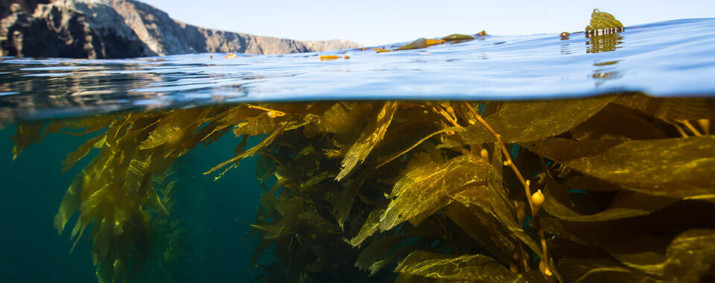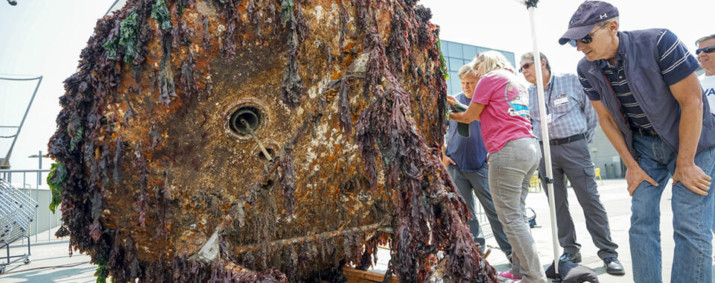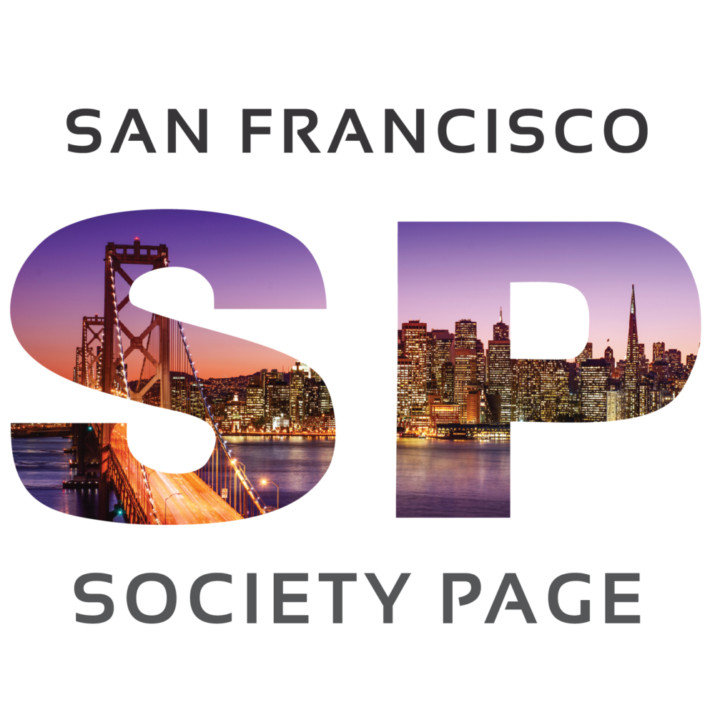
Exploratorium Presents Ocean Buoy and Marine Life Exploration Events
San Francisco, CA. The Exploratorium is gearing up for a series of in-person and online events exploring an ocean buoy and life under the San Franciso Bay. Tickets to attend in-person events, August 19-20, are available for purchase on the Exploratorium website. The online program can be viewed on the Exploratorium’s Facebook page and YouTube channel. In-person and Online Programs Explore Life Under the San Francisco Bay.

There are many other programs.
On Buoy Exploration Day, we’ll provide microscopes, hand lenses, and activities that get you up close and personal with the animals and plants that call San Francisco Bay their home. Scientists from the iNaturalist citizen science team at the California Academy of Sciences will be on hand to identify and catalog the marine organisms, both native and invasive species that live in San Francisco Bay.
The buoy, on loan to us from the National Oceanic and Atmospheric Administration, has been anchored between Piers 15 and 17 since April 2013, collecting data on water temperature, salinity, and carbon dioxide (CO2) levels in the atmosphere and in San Francisco Bay. We pull it out of the water to calibrate and replace the sensors and to clean off corrosion and the growth of marine organisms.
Buoy Days
- Thursday and Friday, August 19-20, 2021, from 10:00 a.m. to 2:00 p.m. PT
- In-person at the Exploratorium on Pier 15
- Tickets are available on the Exploratorium website
Join marine scientists, technicians, and educators as they pull a one-ton NOAA carbon dioxide (CO2) buoy out of the water and explore its scientific instruments and the organisms that have colonized the buoy bottom. Exploratorium staff members will provide a close-up view of maintaining an ocean buoy and discuss the data it collects and why it’s critical to understanding the impacts of excess carbon in the ocean and atmosphere.
On loan from the National Oceanic and Atmospheric Administration (NOAA), the CO2 buoy has been anchored between Piers 15 and 17 since April 2013, collecting data on water temperature, salinity, and CO2 levels in the atmosphere and in San Francisco Bay. Every year, we pull it out of the water to calibrate and replace the sensors and to clean off corrosion and marine organisms.
On Thursday, August 19, visitors will be able to identify microscope organisms with our Living Systems Lab staff members and the iNaturalist team from the California Academy of Sciences. On Friday, August 20, visitors will be able to start their own algae herbarium with a make-and-take activity using algae samples taken from the underside of our buoy and some professional plant preservation supplies.
After Dark: Beneath the Bay
- Thursday, August 19, 2021 • 6:00 p.m. PT
- Adults-only, ages 18+
- In-person at the Exploratorium on Pier 15
- Tickets available on the Exploratorium website
The San Francisco Bay is a dynamic, active system that supports all sorts of ocean organisms. Dive below the surface at this After Dark and see what’s living underneath. Meet the algae and creatures that live underneath our data collection buoy during this once-a-year dry-docking. Find out what historical records of ocean data tell us about the health of the planet, and learn about the possibilities of restoring underwater ecosystems.
Programs throughout the evening include a lecture with researcher Dr. Emily Miller on how kelp and other marine algae from herbaria repositories are helping extend historical records all the way back to 1878; a discussion with diver and ocean advocate, Francesca Koe, on what divers have noticed about recent changes in the North Coast kelp ecosystem and how community science projects are working together to help; algae pressings with Sue Lisin; a selection of film screenings highlighting stories from the sea, and more.
Food and drinks will be available to purchase in our Seaglass Restaurant and at the outdoor bar in Gallery 5 to enjoy in those designated spaces during After Dark. Please note that there is no drinking or eating allowed elsewhere in the museum at this time.
Collecting Kelp – Hybrid Event
- Thursday, August 19, 2021 • 7:30 p.m. PT
- Adults-only, ages 18+
- Hybrid event: Join us live in-person or FREE livestream via YouTube or Facebook
The California coast is a dynamic, active system that supports all sorts of ocean organisms. Dive below the surface at this After Dark Online featuring Ocean Record Keepers with Dr. Emily Miller, inspired by the Exploratorium’s once-a-year dry-docking of our data collection buoy and examination of the organisms that have taken residence on its underside over the past year.
Understanding the future of the ocean requires an understanding of the past. To date, historical data has been largely limited to instrument records and observations that begin around 1950. Research technician Emily Miller shares how kelp and other marine algae from herbaria repositories, and the female scientists who collected them, are helping extend historical records all the way back to 1878.
About Dr. Emily Miller
Dr. Emily A. Miller is a research technician in the Monterey Bay Aquarium Research Institute Incubator Initiative program working with the Environmental Sample Processor (ESP) team. Her research focuses on understanding species responses to dynamic environmental processes over space and time. Emily holds a PhD in ecology from the University of California, Davis, a master’s degree in conservation biology from Columbia University, and a bachelor’s degree in integrative biology from the University of California, Berkeley.
About the Exploratorium
The Exploratorium is a portal to the astonishing scientific phenomena that animate our world and shape our actions. We create extraordinary learning experiences that ignite curiosity, upend perceptions, and inspire brave leaps forward. Since 1969, the Exploratorium’s museum in San Francisco has been home to a renowned collection of exhibits that draw together science, art, and human perception, and that have changed the way science is taught. Our award-winning programs provide a forum for the public to engage with artists, scientists, policymakers, educators, and tinkerers to explore the world around them. We celebrate diversity of thought, inspired investigation, and collaboration across all boundaries
Artworks will be on display at the Exploratorium’s reopening including: “Compound eye” and “Cubatron Core.” Images: Compound eye image courtesy of Kirsten Berg, © Kirsten Berg; Mark Lottor’s Cubatron Core. Image by Amy Snyder, © Exploratorium
Beginning July 1, the Exploratorium will be open Wednesdays through Saturdays, from 10 a.m. to 5 p.m., and Sundays from noon to 5 p.m. The Exploratorium will be closed Mondays and Tuesdays. The museum will also reopen for its popular, adults-only (18+) After Dark events every Thursday evening from 6 p.m. to 10 p.m. beginning July 1. The museum will be open to daytime members and donors only from 10 a.m. to noon every Sunday. Exploratorium memberships are available for purchase online, and new members can make reservations to visit during the member-only days, June 24-27.
Beginning June 24 both dining establishments, Seaglass Restaurant and the Seismic Joint Cafe, will also be reopening. Seaglass will be serving on Thursday evenings from 6 p.m. to 9:30 p.m., and on Saturdays and Sundays from 11 a.m. to 3 p.m. The Seismic Joint Cafe will be serving Wednesdays-Fridays from 10 a.m. to 5 p.m.
The museum’s one-of-a-kind retail store along the Embarcadero will be reopening Wednesdays-Sundays from 10 a.m. to 5:30 p.m, and Thursday evenings until 10:30 p.m. beginning June 24. Museum tickets are not required for shoppers.
More information about health and safety protocols and FAQs about what to expect from your experience are available on the museum’s website. Sign up for Exploratorium emails or follow the museum on social media to stay up-to-date on announcements.
About the Exploratorium
The Exploratorium is a portal to the astonishing scientific phenomena that animate our world and shape our actions. We create extraordinary learning experiences that ignite curiosity, upend perceptions, and inspire brave leaps forward. Since 1969, the Exploratorium’s museum in San Francisco has been home to a renowned collection of exhibits that draw together science, art, and human perception, and that have changed the way science is taught. Our award-winning programs provide a forum for the public to engage with artists, scientists, policymakers, educators, and tinkerers to explore the world around them. We celebrate diversity of thought, inspired investigation, and collaboration across all boundaries.


Artworks will be on display at the Exploratorium’s reopening including: “Compound eye” and “Cubatron Core.” Images: Compound eye image courtesy of Kirsten Berg, © Kirsten Berg; Mark Lottor’s Cubatron Core. Image by Amy Snyder, © Exploratorium




